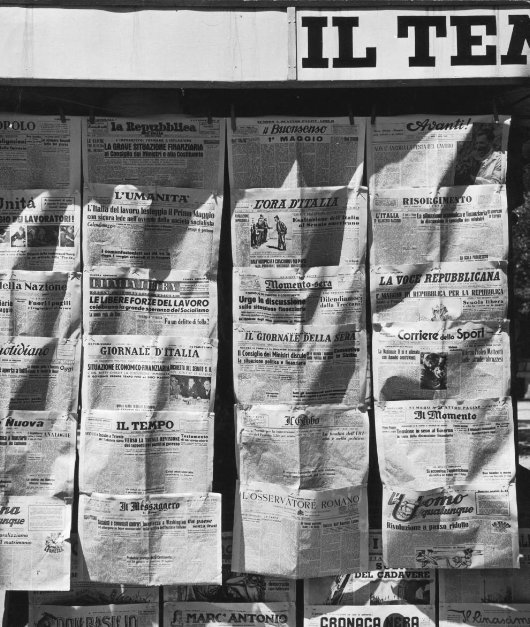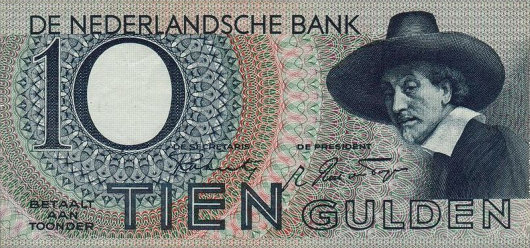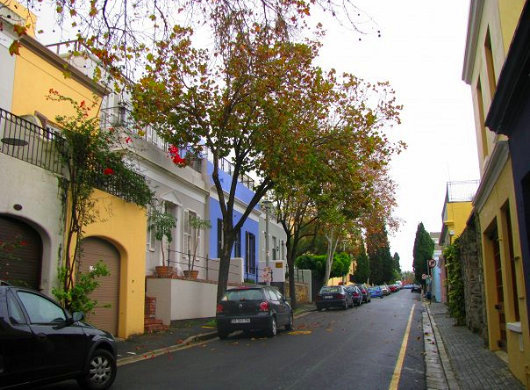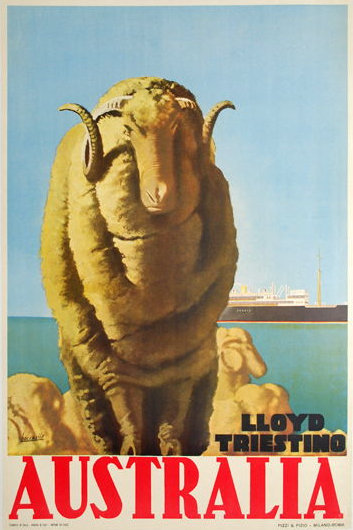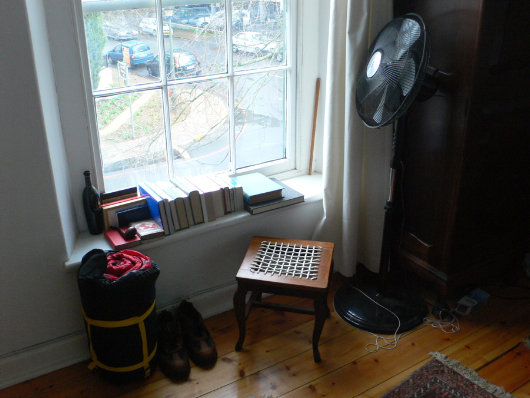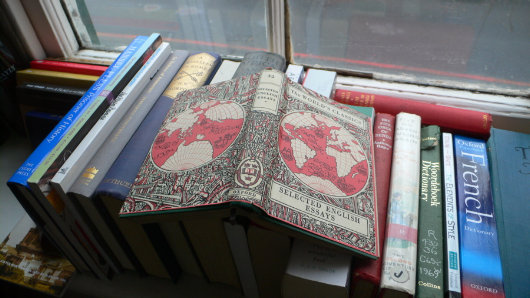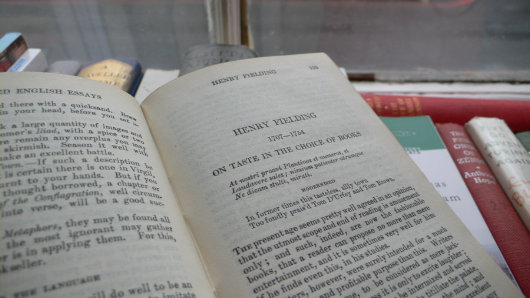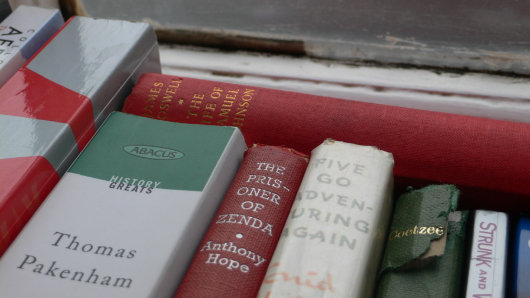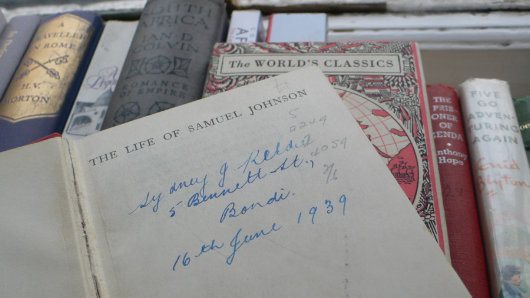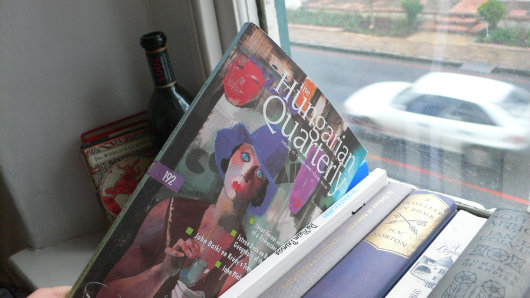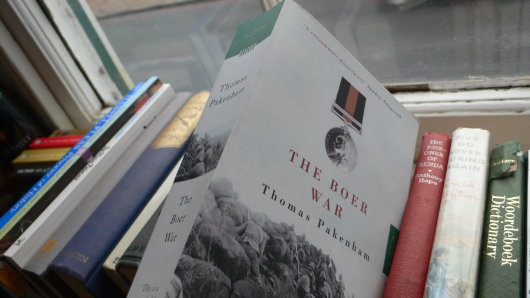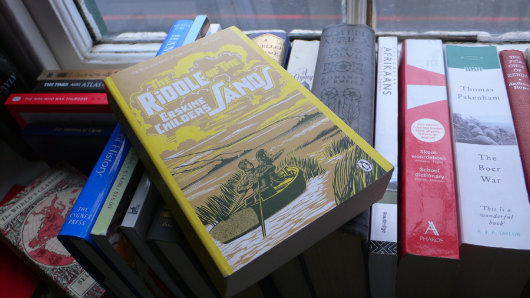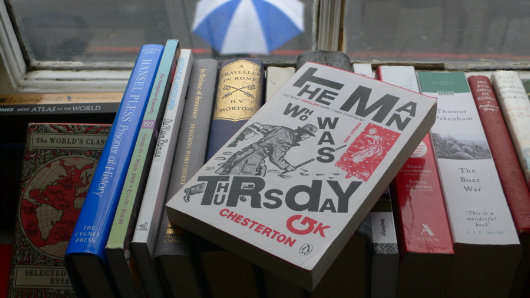Arts & Culture
About Andrew Cusack
 Writer, web designer, etc.; born in New York; educated in Argentina, Scotland, and South Africa; now based in London.
Writer, web designer, etc.; born in New York; educated in Argentina, Scotland, and South Africa; now based in London. read more
News
Blogs
Reviews & Periodicals
Arts & Design
World
France
Mitteleuropa
Knickerbockers
Argentina
The Levant
Africa
Cape of Good Hope
Netherlands
Scandinavia
Québec
India
Muscovy
Germany
Academica
Swanndri
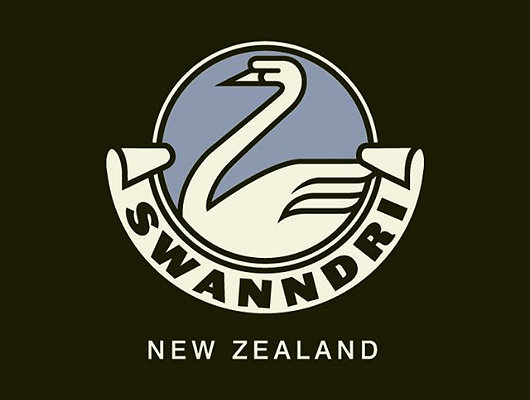
Founded in 1913, this New Zealand outdoor clothing company advertises: “We have to make a good garment. Most of our customers have guns.” Their classic heavy woollen garment with a lace-up section at the neck has been a favourite of Kiwi farmers for decades, but the firm now produces clothing for city-dwellers and outdoor adventurers as well.
I just like their logo.
Richard Demarco
“We didn’t know quite how to take this, but we sat there entranced.”
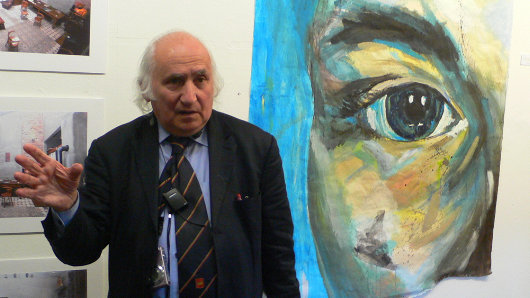
ONE OF THE markedly few deficiencies of the English language is coming up with a word to describe Richard Demarco. The Scottish press have generally settled upon “impresario” but even that somewhat-ambiguous word fails to do the man justice. Ricky was born in Edinburgh in 1930, grew up in Portobello, and remembers the day when his mother held him back from school because Italy — from whence he stock came — had just declared war on Great Britain. He’s attended every Edinburgh Festival since the very first one began in 1947 — as the founders put it, to “provide a platform for the flowering of the human spirit” in the grim aftermath of the Second World War.
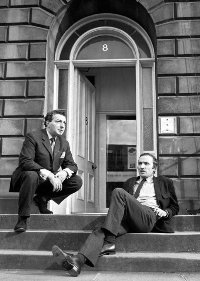 Richard Demarco, couchant, with noted Scots caricaturist Emilio Coia.
Richard Demarco, couchant, with noted Scots caricaturist Emilio Coia.In 1963, he cofounded the Traverse Theatre, Scotland’s theatre for new writing, and three years after that founded the Richard Demarco Gallery which promoted Scotland’s cultural interchange with artists across Europe including — very importantly to Richard — from behind the Iron Curtain that divided the continent into free and captive halves. This was during an age when many in the arts world were too busy sympathizing with the murderous totalitarianism that had subjugated half of Europe. Richard has been a deep critic of the choices made by the British government as patron of the arts throughout the decades of his life, but not too long ago he finally patched things up with the Scottish Arts Council.
Readers of Alexander McCall Smith’s 44 Scotland Street might recall the man who comes to speak to the Scottish Police College. The “really important person from the art world in Edinburgh”, as Mr. McCall Smith puts it, comes and tells the trainee constables about the gorgeousness of Italian carabinieri uniforms and how the Scottish psyche still suffers from the iconoclasm of the Reformation, and even suggests architectural alterations and more sympathetic decoration of the Police College. “We didn’t know quite how to take this, but we sat there entranced,” the character admits in 44 Scotland Street. Anyone who either knows Ricky or has been to one of his lectures would immediately recognize the unnamed subject of the passage.
I first met the man when I was a first-year student at St Andrews and he had come up from the capital to give a lecture. I can’t remember what the stated subject was but this is entirely irrelevant as so vast and wide-ranging is the mind & experience of Richard Demarco that he is known for (some would say “notorious for”) never keeping within the bounds of the stated subject. Those who invite Richard to speak shouldn’t bother with a subject, just make posters stating “RICHARD DEMARCO SPEAKS”, giving the date, time, and place, and a crowd of interested characters is bound to turn up. (more…)
Life of St. Hildegard Hits the Silver Screen
But is it the Hildegard of historical fact or modern fantasy?

THE LIFE OF Saint Hildegard von Bingen — the Benedictine nun, writer, scientist, physician, and poet perhaps best known as a composer — has been brought to the screen in a new German-produced film. “Vision – Aus dem Leben der Hildegard von Bingen” was released in Germany & Austria in September and may receive a wider European release in 2010. From the voluntary confinement of the cloister, this woman corresponded with the Emperors Lothair II and Frederick Barbarossa, the popes Eugene III and Anastasius IV, the great patron of art Abbot Suger, and of course the great Cistercian reformer St. Bernard of Clairvaux. Hildegard was authorised to go on four preaching tours, and her Ordo Virtutum was the first allegorical morality play of the medieval period. She even invented a demi-language, Lingua Ignota (“unknown language”), and created an alternative alphabet in which to write it. (more…)
A Wanderer Anecdote
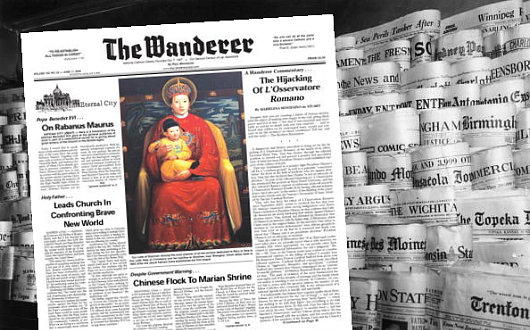
“It’s too easy for theological writers to sling around Abstractions with Capital Letters, as if with each stroke of the pen they’re tapping into Plato’s realm of changeless, ineffable Forms. Or at least that they’re writing in German, where all nouns start with caps.”
So begins John Zmirak, who tells a delightful story about one of America’s premier Catholic newspapers.
“A friend of mine used to write weekly for the estimable investigatory journal The Wanderer. Founded by German-Catholic immigrants, it was published auf Deutsch well into the twentieth century.
As my friend recalled, ‘The editors were, I think, waiting for the rest of the country to catch up with them. At last they admitted that this was unlikely, and agreed to translate the paper. But they kept on as their typesetter someone named Uncle Otto, who for years insisted on capitalizing every noun.’”
The Mitre
I’ve uploaded the last eleven issues of The Mitre — “the quality student newspaper at the University of St Andrews” — before its demise after the Midsummer’s Day issue of 2005. The old Mitre website can be found here.
Unbuilt Pugin in Boston
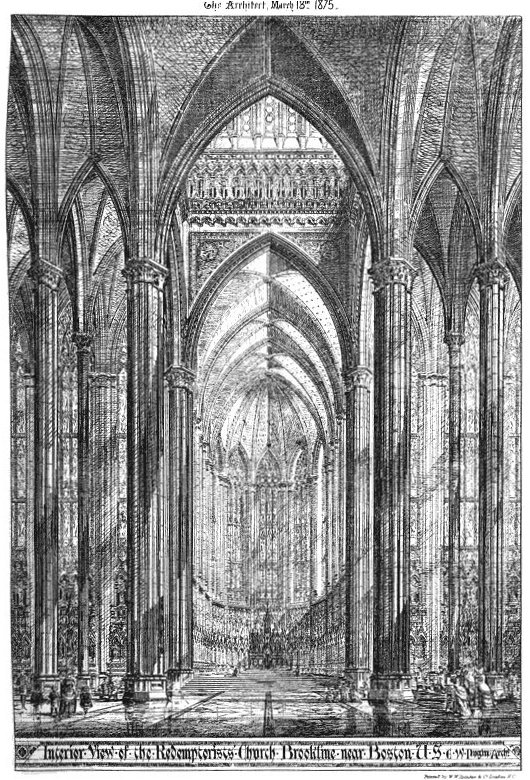
Unbuilt proposal for a Redemptorist church in Boston by Edward Welby Pugin, eldest son of Augustus Welby Northmore Pugin.
An Early Proposal
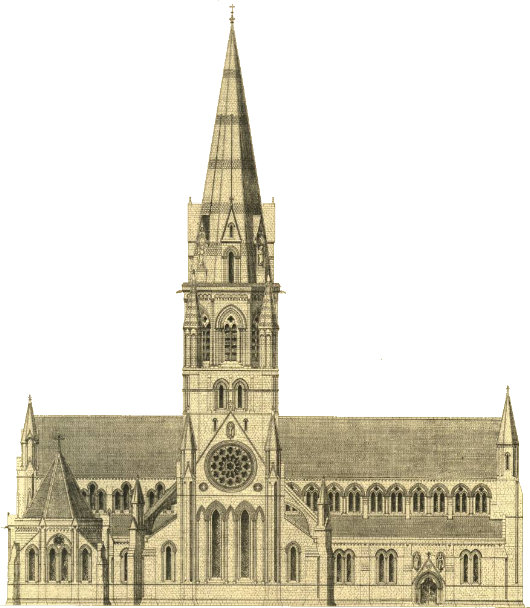
The Cathedral Church of St. Mary (Scottish Episcopal), Edinburgh.
A Viennese Study
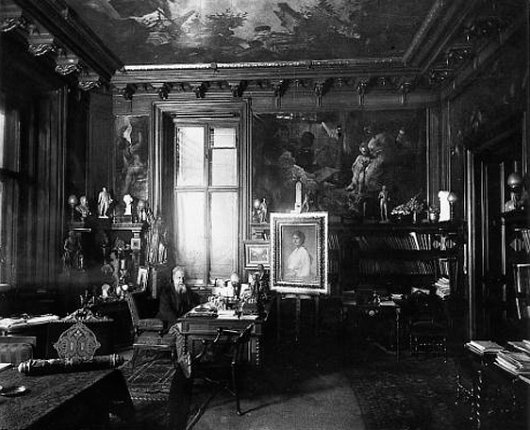
Nikolaus von Dumba, in the study of the Palais Dumba on the Ringstraße in Vienna. (more…)
The Evolving Heraldry of the Dominions
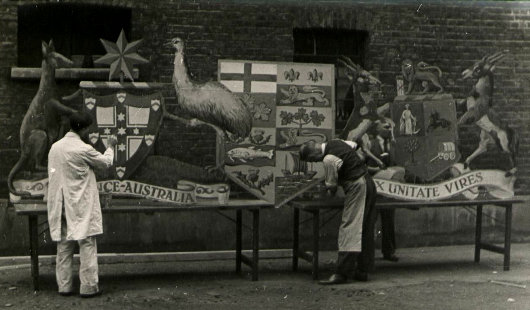
WHAT DO THESE three coats of arms, their representations produced for the 1910 coronation, have in common? The first thing that might come to the mind of most of the heraldically-inclined is that all three are the arms of British dominions; from left to right, of Australia, Canada, and South Africa. Aside from this commonality, however, each of these three arms have been superseded.
The Australian arms above were granted in 1908, and superseded by a new grant in 1912, though the old arms survived on the Australian sixpenny piece as late as 1963. The kangaroo and emu were retained as the shield’s supporters in the new grant of arms which remains in use today.
The Confederation of Canada took place in 1867, but no arms were granted to the dominion so it used a shield with the arms of its four original provinces — Ontario, Québec, Nova Scotia, and New Brunswick — quartered. As the remaining colonies of British North America were admitted to Canada as provinces, their arms were added to the unofficial dominion arms, which became quite cumbersome as the number of provinces grew. A better-designed coat of arms was officially granted in 1921, and modified only slightly a number of times since then.
South Africa‘s heraldic achievement, meanwhile, was divided into quarters, each quarter representing one of the Union’s four provinces: the Cape of Good Hope, Natal, the Transvaal, and the Orange Free State. While South Africa is (like Scotland, England, Ireland, and Canada) one of the few countries to have an official heraldic authority — the Buro vir Heraldiek in Pretoria — the country’s new arms were designed by a graphic designer with little knowledge of the rules & traditions of heraldry. As a result, the design produced is unattractive and very unpopular, unlike the new South African national flag, introduced in 1994, which was designed by the State Herald, Frederick Brownell, which enjoys wide popularity and universal acceptance.
The current arms of Australia, Canada, and South Africa are represented below.
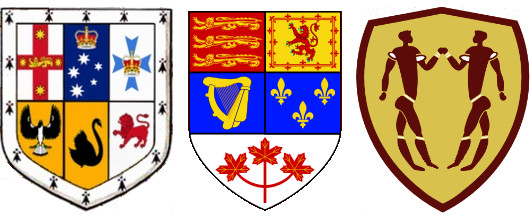
The Church of Howard Johnson
Beware disgruntled anthroposophists
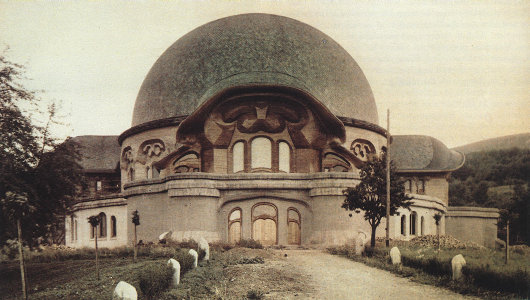
Readers will be interested to learn that two friends of mine, Mr. Stephen Klimczuk and The Much Honoured The Laird Gerald Warner of Craiggenmaddie, have collaborated on a book that looks to be of great interest. Secret Places, Hidden Sanctuaries depicts in detail many of the world’s secret nooks and crannies, from mystical sites to enigmatic bolt-holes, debunking myths and positing plausible theories along the way.
After taking an enticing gander at the book’s table of contents, it’s worth popping over to “Curated Secrets”, the blog through which the book’s two authors correspond with one another. The blog already features a picture of the first Goetheanum, the original world center of Rudolf Steiner’s movement that was burnt down by a disgruntled anthroposophist on New Year’s Eve 1922.
Nature diary
by ‘REDSHANK’
To many, the end of summer and onset of autumn brings melancholy thoughts but for us in the nature diarist community it has many consolations as the season unfolds, bringing all the traditional customs still observed in our part of the countryside.
Old Seth the wasp-keeper, last of a dying breed, has now celebrated the age-old custom of “telling the wasps”, when he gathers his vespine charges about him and confides, with their buzzing approval, all the notable events that are taking place in our neighbourhood: actual and grievous bodily harm, rape, fraud and the formation of new gangs of hooligans of ever-increasing ferocity.
 This is the season when late groups of water colourists invade our neighbourhood with their easels and brushes, under the aegis of the big ginger-haired old fellow who seems to hold them in a state of awe and even terror, making no secret of his utter contempt for their efforts.
This is the season when late groups of water colourists invade our neighbourhood with their easels and brushes, under the aegis of the big ginger-haired old fellow who seems to hold them in a state of awe and even terror, making no secret of his utter contempt for their efforts.
“Now pay attention!” he can be heard roaring miles away. “First get control of your picture space. I well remember my old friend Jack Constable telling me that command of your picture space was half the battle, and you could forget all about composition, structure, tonal harmony, conceptual values and all the rest of the stuff you learnt at art school.”
His group of amateur artists, mostly pensioners and elderly people who have been advised by their psychiatrists to get something to do, and old ladies who seem unable to distinguish between paintbrushes and knitting needles, received his advice with reverence, positively elated that he should speak to them at all.
I felt rather sorry for them, but mindful of the belief, common among the village people, that any contact with these strange folk can bring misfortune, I did not intervene, even when a pathetic old pensioner with several hearing aids grasped my arm and begged me wordlessly for help.
The whole group disappeared over the brow of Mandelson’s Hill preceded by the ginger-haired leader, who is still shouting about “Bill” Monet and other eminent painters he had known, waving an outsized paintbrush, and I saw them no more.
Oddly enough, the country folk have great respect for him and seem to regard him as some kind of enchanter. Certainly they believe that all the creatures of the wild, from magpies to badgers, will come to his call. He lives in a big rambling old house with a large overgrown garden where he can be seen sitting and meditating on the secrets of nature. Old Frank the gamekeeper swears that once, peering through a gap in the garden wall, he saw him sitting amid the brambles and deadly nightshade with a huge Andean condor perched on his shoulder as he whispered his secrets to it.
The country folk call this enchanted garden “an European eco-habitat” and are agitating for an official warden with a degree in environmental studies.
The Rhodes Memorial
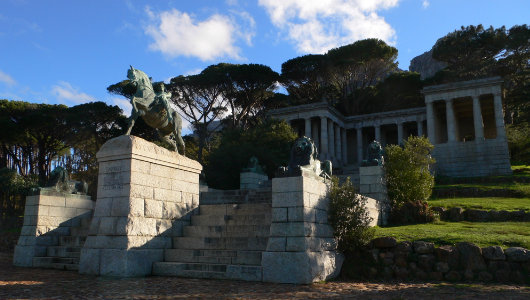
PERCHED AMID THE bluegum trees on the slopes of Devil’s Peak in Cape Town is the memorial to one of the most brilliant & cunning men the world has ever produced. Cecil John Rhodes may have been born in Bishop’s Stortford, England, but his worldly glories all emanated from the Cape of Good Hope, and so it’s appropriate that his memorial stands here in Cape Town. His first commercial enterprise in South Africa was founding the Rhodes Fruit Farms (now Rhodes Food Group) which still exist on the road from Stellenbosch to Franschhoek, and has since expanded throughout the Western Cape, and to the Transvaal and Swaziland. But it was his creation of the diamond monopoly De Beers out of the Kimberley mines that made him one of the wealthiest men in the world. Ten years after being elected to the Cape Parliament, he was made Prime Minister of the Cape in 1890, but his catastrophic and illegal attempt to seize the independent Transvaal in 1895 forced his resignation from politics in disgrace. (more…)
The Union Defence Force
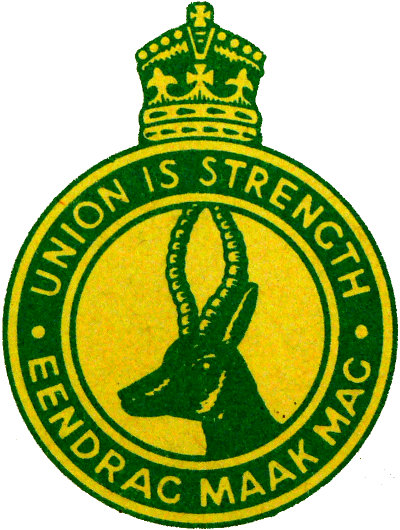
From 1912 to 1957, South Africa’s military was called the Union Defence Force (the Union in question being the Union of South Africa, the other USA). The Nationalist government renamed it the South African Defence Force (Suid-Afrikaanse Weermag) in 1957, prior to the declaration of the Republic of South Africa in 1961. After the introduction of universal suffrage in 1994, the SADF was merged with the MK (Umkhonto we Sizwe, the ANC’s terror branch) and APLA (Azanian People’s Liberation Army, the terrorist wing of the Pan-Africanist Congress), as well as the Self-Protection Units of Prince Mangosuthu Buthelezi’s Inkatha Freedom Party, into the South African National Defense Force (SANDF, or SANDEF), which remains the name of the country’s armed forces today.
Search
Instagram: @andcusack
Click here for my Instagram photos.Most Recent Posts
- Amsterdam November 26, 2024
- Silver Jubilee November 21, 2024
- Articles of Note: 11 November 2024 November 11, 2024
- Why do you read? November 5, 2024
- India November 4, 2024
Most Recent Comments
- on The Catholic Apostolic Church, Edinburgh
- on Articles of Note: 11 November 2024
- on Articles of Note: 11 November 2024
- on Why do you read?
- on Why do you read?
- on University Nicknames in South Africa
- on The Situation at St Andrews
- on An Aldermanian Skyscraper
- on Equality
- on Rough Notes of Kinderhook
Book Wishlist
Monthly Archives
Categories

